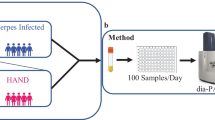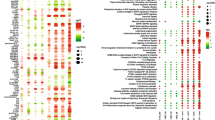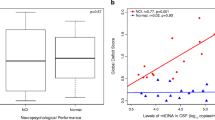Abstract
We identified and measured proteins in the cerebral spinal fluid (CSF) involved in HIV-associated neurological disorders. Protein levels were determined by mass spectrometry (MS) in pooled CSF taken from three patient groups (human immunodeficiency virus (HIV)-1-infected patients that developed HIV-associated neurocognitive disorders (HANDs), HIV-1-infected patients without HAND, and healthy controls). Pools were generated from 10 patients each per group. CSF from individual patient groups were digested with trypsin and separately labeled using with isobaric tags for relative and absolute quantitation (iTRAQ). After combining all samples in one, peptides were extensively fractionated by offline two-dimensional separation and identified by tandem MS. One hundred and ninety three proteins were deemed to be interpretable for quantitation based on permutation tests with a 95 % confidence interval with a p value ≤ 0.05. Using a cutoff of 1.5-fold for upregulation and 0.6 for downregulation, 16 proteins were differentially expressed in HIV + HAND (reporter p value ≤0.05) with seven of them previously described as HIV-interacting proteins: endoplasmin, mitochondrial damage mediator-BH3-interacting domanin death agonist, orosomucoid, apolipoprotein E, metalloproteinase inhibitor 2, peroxiredoxin-2, and the nuclear protein, ruvB-like 2. Several previously unidentified proteins with possible neurological implication in HIV patients include forming-binding protein 1, C-reactive protein, leukocyte-associated immunoglobulin receptor 1, renin receptor, mediator of RNA polymerase II transcription subunit 14, multimerin-2, alpha-N-acetylglucosaminidase, caldesmon, and cadherin EGF LAG G-type receptor. Our results suggest that not only a few but possibly a combination of biomarkers that are highly correlated can predict neurocognitive status in HIV-infected patients and might be involved in monocyte or macrophage activation.




Similar content being viewed by others
References
Aggarwal A, Iemma TL, Shih I, Newsome TP, McAllery S et al (2012) Mobilization of HIV spread by diaphanous 2 dependent filopodia in infected dendritic cells. PLoS Pathog 8:e1002762
Alpert AJ, Andrews PC (1988) Cation-exchange chromatography of peptides on poly(2-sulfoethyl aspartamide)-silica. J Chromatogr 443:85–96
Antinori A, Arendt G, Becker JT, Brew BJ, Byrd DA et al (2007) Updated research nosology for HIV-associated neurocognitive disorders. Neurology 69:1789–1799
Atemezem A, Mbemba E, Vassy R, Slimani H, Saffar L, Gattegno L (2001) Human alpha1-acid glycoprotein binds to CCR5 expressed on the plasma membrane of human primary macrophages. Biochem J 356:121–128
Bantscheff M, Boesche M, Eberhard D, Matthieson T, Sweetman G, Kuster B (2008) Robust and sensitive iTRAQ quantification on an LTQ Orbitrap mass spectrometer. Mol Cell Proteomics 7:1702–1713
Boehm AM, Putz S, Altenhofer D, Sickmann A, Falk M (2007) Precise protein quantification based on peptide quantification using iTRAQ. BMC Bioinformatics 8:214
Boutin C, Goffinet AM, Tissir F (2012) Celsr1-3 cadherins in PCP and brain development. Curr Top Dev Biol 101:161–183
Chico L, Simoncini C, Lo Gerfo A, Rocchi A, Petrozzi L et al (2013) Oxidative stress and APO E polymorphisms in Alzheimer’s disease and in mild cognitive impairment. Free Radic Res 47:569–576
Choe LH, Aggarwal K, Franck Z, Lee KH (2005) A comparison of the consistency of proteome quantitation using two-dimensional electrophoresis and shotgun isobaric tagging in Escherichia coli cells. Electrophoresis 26:2437–2449
Cousin C, Bracquart D, Contrepas A, Corvol P, Muller L, Nguyen G (2009) Soluble form of the (pro)renin receptor generated by intracellular cleavage by furin is secreted in plasma. Hypertension 53:1077–1082
Gan CS, Chong PK, Pham TK, Wright PC (2007) Technical, experimental, and biological variations in isobaric tags for relative and absolute quantitation (iTRAQ). J Proteome Res 6:821–827
Gautier VW, Gu L, O’Donoghue N, Pennington S, Sheehy N, Hall WW (2009) In vitro nuclear interactome of the HIV-1 Tat protein. Retrovirology 6:47
Hayward CP (1997) Multimerin: a bench-to-bedside chronology of a unique platelet and endothelial cell protein–from discovery to function to abnormalities in disease. Clin Invest Med 20:176–187
Heaton R. 2012a. Asymptomatic mild HIV-associated neurocognitive disorder increases risk for future symptomatic decline: a CHARTER longitudinal study. 19th CROI, 2012, Seattle. Oral abstract 81.
Heaton R. 2012b. Prevalence and predictors of neurocognitive decline over 18 to 42 Months: a CHARTER longitudinal study. 19th CROI, Seattle. Poster abstract 474.
Herbrich SM, Cole RN, West KP Jr, Schulze K, Yager JD et al (2013) Statistical inference from multiple iTRAQ experiments without using common reference standards. J Proteome Res 12:594–604
Hu J, Qian J, Borisov O, Pan S, Li Y et al (2006) Optimized proteomic analysis of a mouse model of cerebellar dysfunction using amine-specific isobaric tags. Proteomics 6:4321–4334
Huang X, Stone DK, Yu F, Zeng Y, Gendelman HE (2010) Functional proteomic analysis for regulatory T cell surveillance of the HIV-1-infected macrophage. J Proteome Res 9:6759–6773
Impens F, Timmerman E, Staes A, Moens K, Arien KK et al (2012) A catalogue of putative HIV-1 protease host cell substrates. Biol Chem 393:915–931
Jeimy SB, Tasneem S, Cramer EM, Hayward CP (2008) Multimerin 1. Platelets 19:83–95
Karim S, Hopkins S, Purandare N, Crowther J, Morris J, et al. 2013. Peripheral inflammatory markers in amnestic mild cognitive impairment. Int J Geriatr Psychiatry
Karp NA, Huber W, Sadowski PG, Charles PD, Hester SV, Lilley KS (2010) Addressing accuracy and precision issues in iTRAQ quantitation. Mol Cell Proteomics 9:1885–1897
Keller A, Nesvizhskii AI, Kolker E, Aebersold R (2002) Empirical statistical model to estimate the accuracy of peptide identifications made by MS/MS and database search. Anal Chem 74:5383–5392
Keshamouni VG, Michailidis G, Grasso CS, Anthwal S, Strahler JR et al (2006) Differential protein expression profiling by iTRAQ-2DLC-MS/MS of lung cancer cells undergoing epithelial-mesenchymal transition reveals a migratory/invasive phenotype. J Proteome Res 5:1143–1154
Kreipke CW, Morgan NC, Petrov T, Rafols JA (2006) Calponin and caldesmon cellular domains in reacting microvessels following traumatic brain injury. Microvasc Res 71:197–204
Lafrenie RM, Wahl LM, Epstein JS, Hewlett IK, Yamada KM, Dhawan S (1996a) HIV-1-Tat modulates the function of monocytes and alters their interactions with microvessel endothelial cells. A mechanism of HIV pathogenesis. J Immunol 156:1638–1645
Lafrenie RM, Wahl LM, Epstein JS, Hewlett IK, Yamada KM, Dhawan S (1996b) HIV-1-Tat protein promotes chemotaxis and invasive behavior by monocytes. J Immunol 157:974–977
Letendre S. 2012. A concise panel of biomarkers diagnoses and predicts neurocognitive status in HIV-infected individuals. 19th CROI, 2012, Seattle. Oral abstract 82.
Lin WT, Hung WN, Yian YH, Wu KP, Han CL et al (2006) Multi-Q: a fully automated tool for multiplexed protein quantitation. J Proteome Res 5:2328–2338
Lin CC, Chang CM, Liu CY, Huang TL (2013) Increased high-sensitivity C-reactive protein levels in Taiwanese schizophrenic patients. Asia Pac Psychiatry 5:E58–E63
Linde ME, Colquhoun DR, Ubaida Mohien C, Kole T, Aquino V, et al. 2013. The conserved set of host proteins incorporated into HIV-1 virions suggests a common egress pathway in multiple cell types. J Proteome Res
Liu Y, Jones M, Hingtgen CM, Bu G, Laribee N et al (2000) Uptake of HIV-1 tat protein mediated by low-density lipoprotein receptor-related protein disrupts the neuronal metabolic balance of the receptor ligands. Nat Med 6:1380–1387
Mahoney DW, Therneau TM, Heppelmann CJ, Higgins L, Benson LM et al (2011) Relative quantification: characterization of bias, variability and fold changes in mass spectrometry data from iTRAQ-labeled peptides. J Proteome Res 10:4325–4333
McArthur JC, McDermott MP, McClernon D, St Hillaire C, Conant K et al (2004) Attenuated central nervous system infection in advanced HIV/AIDS with combination antiretroviral therapy. Arch Neurol 61:1687–1696
Mohamed MA, Barker PB, Skolasky RL, Selnes OA, Moxley RT et al (2010) Brain metabolism and cognitive impairment in HIV infection: a 3-T magnetic resonance spectroscopy study. Magn Reson Imaging 28:1251–1257
Navare AT, Sova P, Purdy DE, Weiss JM, Wolf-Yadlin A et al (2012) Quantitative proteomic analysis of HIV-1 infected CD4+ T cells reveals an early host response in important biological pathways: protein synthesis, cell proliferation, and T-cell activation. Virology 429:37–46
Nesvizhskii AI, Keller A, Kolker E, Aebersold R (2003) A statistical model for identifying proteins by tandem mass spectrometry. Anal Chem 75:4646–4658
Nie Z, Phenix BN, Lum JJ, Alam A, Lynch DH et al (2002) HIV-1 protease processes procaspase 8 to cause mitochondrial release of cytochrome c, caspase cleavage and nuclear fragmentation. Cell Death Differ 9:1172–1184
Ow SY, Salim M, Noirel J, Evans C, Rehman I, Wright PC (2009) iTRAQ underestimation in simple and complex mixtures: “the good, the bad and the ugly”. J Proteome Res 8:5347–5355
Park SE, Lee MJ, Yang MH, Ahn KY, Jang SI et al (2007) Expression profiles and pathway analysis in HEK 293 T cells overexpressing HIV-1 Tat and nucleocapsid using cDNA microarray. J Microbiol Biotechnol 17:154–161
Pendyala G, Trauger SA, Siuzdak G, Fox HS (2010) Quantitative plasma proteomic profiling identifies the vitamin E binding protein afamin as a potential pathogenic factor in SIV induced CNS disease. J Proteome Res 9:352–358
Pichler P, Kocher T, Holzmann J, Mazanek M, Taus T et al (2010) Peptide labeling with isobaric tags yields higher identification rates using iTRAQ 4-plex compared to TMT 6-plex and iTRAQ 8-plex on LTQ Orbitrap. Anal Chem 82:6549–6558
Pocernich CB, Sultana R, Hone E, Turchan J, Martins RN et al (2004) Effects of apolipoprotein E on the human immunodeficiency virus protein Tat in neuronal cultures and synaptosomes. J Neurosci Res 77:532–539
Pottiez G, Wiederin J, Fox HS, Ciborowski P (2012) Comparison of 4-plex to 8-plex iTRAQ quantitative measurements of proteins in human plasma samples. J Proteome Res 11:3774–3781
Price RW, Peterson J, Fuchs D, Angel TE, Zetterberg H et al (2013) Approach to cerebrospinal fluid (CSF) biomarker discovery and evaluation in HIV infection. Journal of neuroimmune pharmacology : the official journal of the Society on NeuroImmune Pharmacology 8:1147–1158
Rabehi L, Ferriere F, Saffar L, Gattegno L (1995) Alpha 1-acid glycoprotein binds human immunodeficiency virus type 1 (HIV-1) envelope glycoprotein via N-linked glycans. Glycoconj J 12:7–16
Sadigh-Eteghad S, Talebi M, Farhoudi M (2012) Association of apolipoprotein E epsilon 4 allele with sporadic late onset Alzheimer’s disease. A meta-analysis Neurosciences (Riyadh) 17:321–326
Schouten J, Cinque P, Gisslen M, Reiss P, Portegies P (2011) HIV-1 infection and cognitive impairment in the cART era: a review. Aids 25:561–575
Shadforth IP, Dunkley TP, Lilley KS, Bessant C. 2005. i-Tracker: for quantitative proteomics using iTRAQ. BMC Genomics 6: 145
Shetty V, Jain P, Nickens Z, Sinnathamby G, Mehta A, Philip R (2011) Investigation of plasma biomarkers in HIV-1/HCV mono- and coinfected individuals by multiplex iTRAQ quantitative proteomics. Omics 15:705–717
Snyder A, Alsauskas ZC, Leventhal JS, Rosenstiel PE, Gong P et al (2010) HIV-1 viral protein r induces ERK and caspase-8-dependent apoptosis in renal tubular epithelial cells. Aids 24:1107–1119
Tharakan R, Edwards N, Graham DR (2010) Data maximization by multipass analysis of protein mass spectra. Proteomics 10:1160–1171
Toschi E, Barillari G, Sgadari C, Bacigalupo I, Cereseto A et al (2001) Activation of matrix-metalloproteinase-2 and membrane-type-1-matrix-metalloproteinase in endothelial cells and induction of vascular permeability in vivo by human immunodeficiency virus-1 Tat protein and basic fibroblast growth factor. Mol Biol Cell 12:2934–2946
Tun C, Guo W, Nguyen H, Yun B, Libby RT et al (2007) Activation of the extrinsic caspase pathway in cultured cortical neurons requires p53-mediated down-regulation of the X-linked inhibitor of apoptosis protein to induce apoptosis. J Neurochem 102:1206–1219
Turchan-Cholewo J, Liu Y, Gartner S, Reid R, Jie C et al (2006) Increased vulnerability of ApoE4 neurons to HIV proteins and opiates: protection by diosgenin and L-deprenyl. Neurobiol Dis 23:109–119
Tzoupis H, Leonis G, Megariotis G, Supuran CT, Mavromoustakos T, Papadopoulos MG (2012) Dual inhibitors for aspartic proteases HIV-1 PR and renin: advancements in AIDS-hypertension-diabetes linkage via molecular dynamics, inhibition assays, and binding free energy calculations. J Med Chem 55:5784–5796
Uzasci L, Nath A, Cotter R. 2013. Oxidative stress and the HIV-infected brain proteome. J Neuroimmune Pharmacol
Verghese PB, Castellano JM, Garai K, Wang Y, Jiang H et al (2013) ApoE influences amyloid-beta (Abeta) clearance despite minimal apoE/Abeta association in physiological conditions. Proc Natl Acad Sci U S A 110:E1807–E1816
Wang Y, Yang F, Gritsenko MA, Wang Y, Clauss T et al (2011) Reversed-phase chromatography with multiple fraction concatenation strategy for proteome profiling of human MCF10A cells. Proteomics 11:2019–2026
Wu WW, Wang G, Baek SJ, Shen RF (2006) Comparative study of three proteomic quantitative methods, DIGE, cICAT, and iTRAQ, using 2D gel- or LC-MALDI TOF/TOF. J Proteome Res 5:651–658
Zieske LR (2006) A perspective on the use of iTRAQ reagent technology for protein complex and profiling studies. J Exp Bot 57:1501–1508
Acknowledgments
The authors would like to acknowledge the following funding sources for this work: Center for Novel Therapeutics for HIV-Associated Cognitive Disorders, NIMH Center grant 2P30MH075673, and NHLBI Contract No. HHSN268201000032C. CSF was collected from patients that provided informed consent and under protocols approved by the appropriate institutional review boards. We would like to acknowledge that mass spectrometry for these studies were performed in the Johns Hopkins University School of Medicine Mass Spectrometry and Proteomics Core facility (Dr. Robert Cole, Director).
Conflict of interest
The authors declare they have no financial relationship with the organization that sponsors this research; therefore, they have no conflict of interest.
Dedication
The authors would like to dedicate this manuscript to the late Dr. Robert Cotter, who passed away during the preparation of this manuscript. His friendship, guidance, and support will be greatly missed.
Author information
Authors and Affiliations
Corresponding author
Rights and permissions
About this article
Cite this article
Bora, A., Mohien, C.U., Chaerkady, R. et al. Identification of putative biomarkers for HIV-associated neurocognitive impairment in the CSF of HIV-infected patients under cART therapy determined by mass spectrometry. J. Neurovirol. 20, 457–465 (2014). https://doi.org/10.1007/s13365-014-0263-5
Received:
Revised:
Accepted:
Published:
Issue Date:
DOI: https://doi.org/10.1007/s13365-014-0263-5




